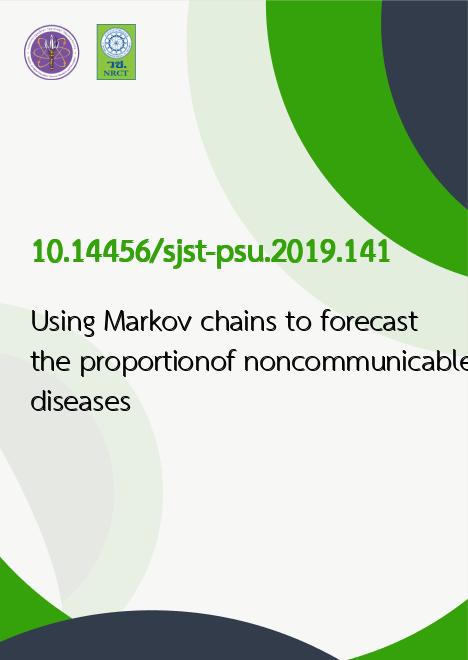
|
Using Markov chains to forecast the proportionof noncommunicable diseases |
|---|---|
| รหัสดีโอไอ | |
| Creator | 1. Vadhana Jayathavaj 2. Pranee Boonya |
| Title | Using Markov chains to forecast the proportionof noncommunicable diseases |
| Publisher | Research and Development Office, Prince of Songkla University |
| Publication Year | 2562 |
| Journal Title | Songklanakarin Journal of Science and Technology |
| Journal Vol. | 41 |
| Journal No. | 5 |
| Page no. | 1124-1130 |
| Keyword | Markov chain, noncommunicable diseases, proportion, state, step |
| URL Website | http://rdo.psu.ac.th/sjstweb/index.php |
| ISSN | 0125-3395 |
| Abstract | The university personnel annual medical check-up reports of the years 2015-2017 are classified by the 16 categories ofnoncommunicable diseases (NCDs) from the combinations of the 4 criteria: high fasting blood sugar, high blood pressure, hightriglycerides or high cholesterol or high low-density lipoprotein, and the abnormal signs from an electrocardiogram. This studyaims to project the future proportion of NCDS in order to reflect the past and current university health policy. The Markov chainsare the categorical time series prediction model that are applied to identify the probabilities of short-run and long-run events foreach NCD states (category). The estimated state probability of the year 2017 that is derived from the transition matrix of the year2015 to 2016 is close to the real state probability of the year 2017 using the Chi-squared goodness of fit test (p-value < 0.002,degrees of freedom 15). The prediction for the steps of short-run (2018-2019) and long-run (2022 and so on) show that theNCDs with many more combinations will increase about 1% each, while the NCDs with lesser combinations will decrease by 1%each. |
